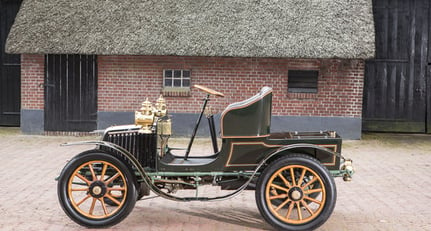1902 Renault 8
-
Baujahr1902
-
Chassisnummer114
-
Motornummer7201
-
Losnummer215
-
LenkungLenkung links
-
ZustandGebraucht
-
Zahl der Sitze2
-
Standort

-
AußenfarbeSonstige
-
Antrieb2wd
-
KraftstoffPetrol
Beschreibung
1902 Renault 8hp Type G Two-Seater
Chassis no. 114
Engine no. 7201
Founded in 1898 by Louis Renault and his brothers Marcel and Fernand, the company that would become France's biggest automobile manufacturer started humbly enough, with a solitary 1¾hp De Dion-engined prototype, the sprung rear axle of which would soon be copied by many contemporaries. At a time when automobile design had yet to crystallise, Renault's front-engined, rear-drive design presaged that of the modern car, while other advanced features included wire-spoked wheels shod with the newly invented Dunlop inflatable tyre. Few changes were found necessary before the Type A was ready for presentation to the public in 1899. Production at the Billancourt factory was soon under way on a large scale, demand for its products being enhanced by the performance of Renault cars in the great inter-city races so popular in France at the turn of the 19th Century.
The single-cylinder Renault was updated annually, the Type G of 1902 featuring an 864cc water-cooled De Dion motor rated at 6hp. Twin, side-mounted radiators had been adopted when water-cooling arrived in 1900 on the Type C and these were enlarged for the Type G, which was the first model to feature Renault's so-called 'coal scuttle' bonnet, a style widely copied by other manufacturers. The largest Renault model so far, the Type G was built on a longer and wider chassis, made from heavier gauge tubing, which now relied on semi-elliptic springing instead of the fully elliptical springs favoured hitherto. By this time a circular steering wheel on an inclined column had been standardised, replacing the semi-circular control and vertical column used since production began. Six alternative final drive ratios were available, giving the car a top speed of anywhere between 19 and 33mph approximately. 1902 is also particularly noteworthy as the year the company began making its own engines, one of which powered Marcel Renault to a remarkable victory in that year's Paris-Vienna Race, defeating the larger Panhard-Levassor opposition to achieve worldwide acclaim and recognition for Renault products.
From the outset Renault engineering was of the highest quality, as exemplified by this 8hp De Dion-engined Type G, which is typical of the first generation of Renault automobiles. Chassis number '114' was in the Mahy Collection in Brussels, Belgium during the 1960s, moving to the Gerard Vaasen Collection in Holland around 1980. From 1998 onwards it formed part of the Broos Collection in Holland, passing to the current vendor in 2013.
The car has Renault's trademark twin, side-mounted, gilled tube radiators while the two-seater coachwork is in the style of the period. It is most attractively presented in dark green livery with deep-buttoned black leather upholstery, and is equipped with a magnificent pair of brass side lamps by C Ouvrard et Cie, Paris and a Ducellier rear light. The supplying dealer's plate is still attached. Restored circa 2000, most of the wood being replaced while all the original metalwork was retained, the car is presented today in generally excellent running and driving condition. Accompanying documentation consists of correspondence, historical information, technical diagrams, starting instructions (in Dutch) and Netherlands registration papers.
This delightful smaller Renault is well catered for by both the Veteran Car Club and the Renault Frères and, of course, is eligible for the London-Brighton Run.

























